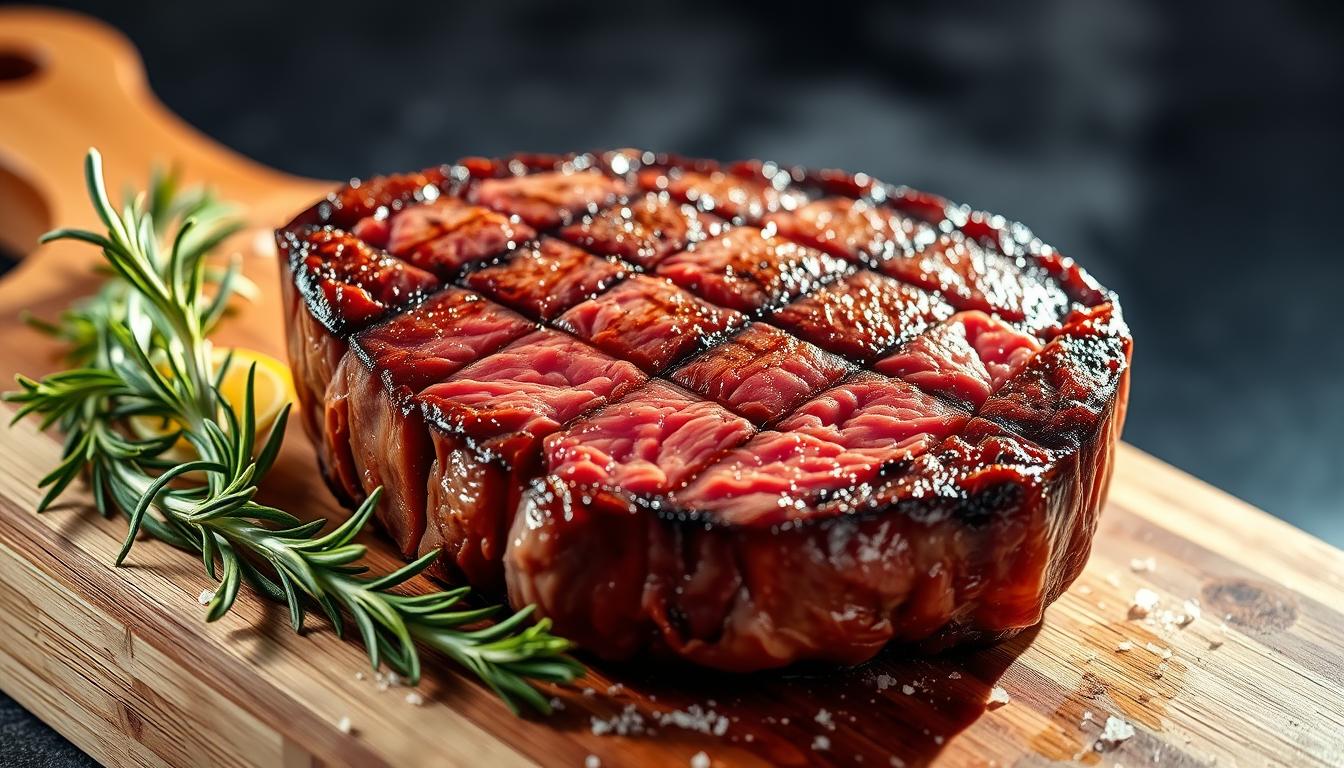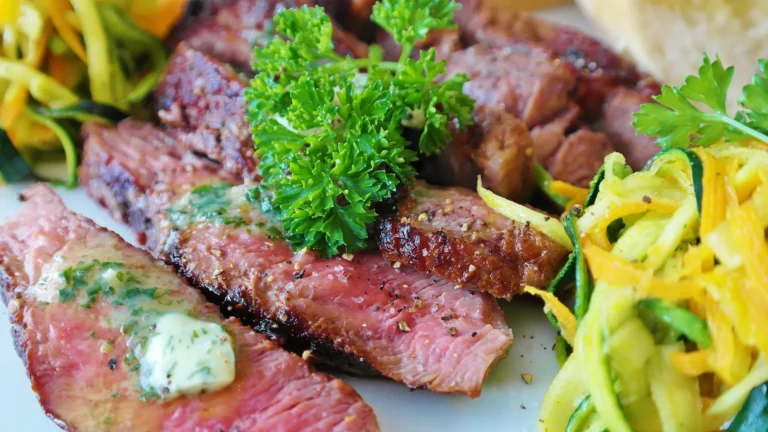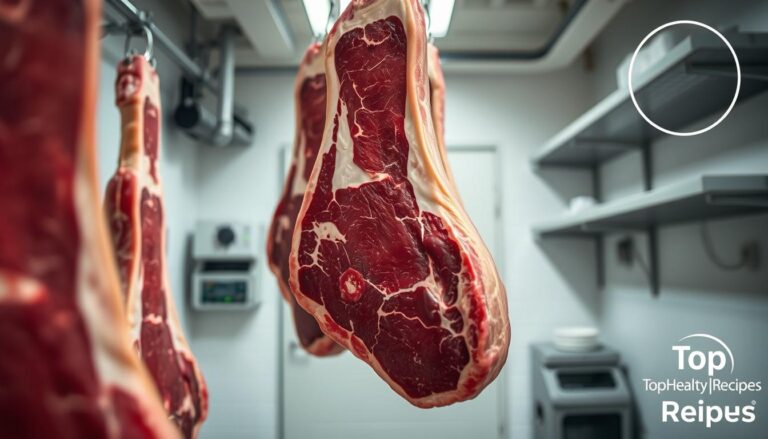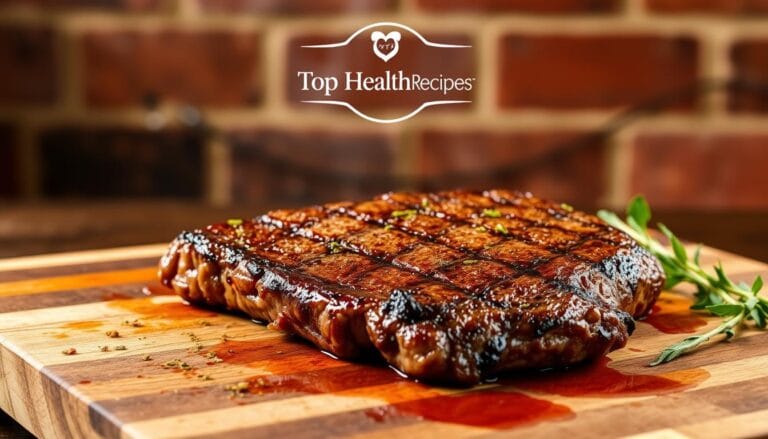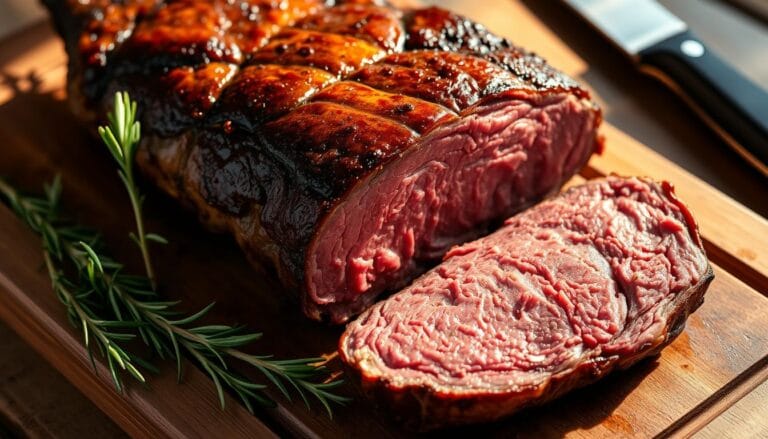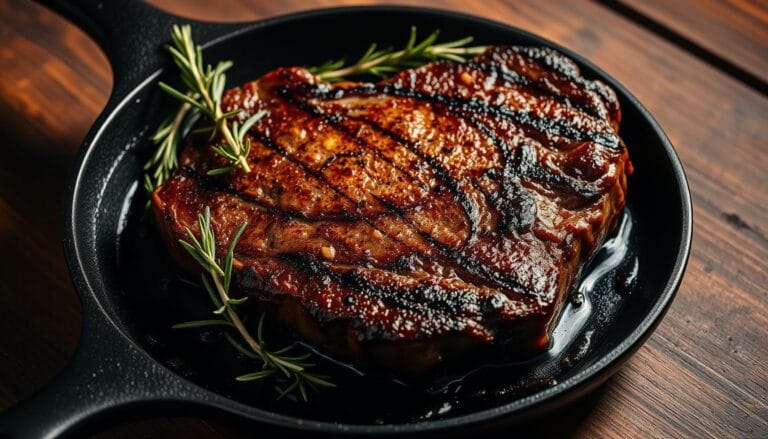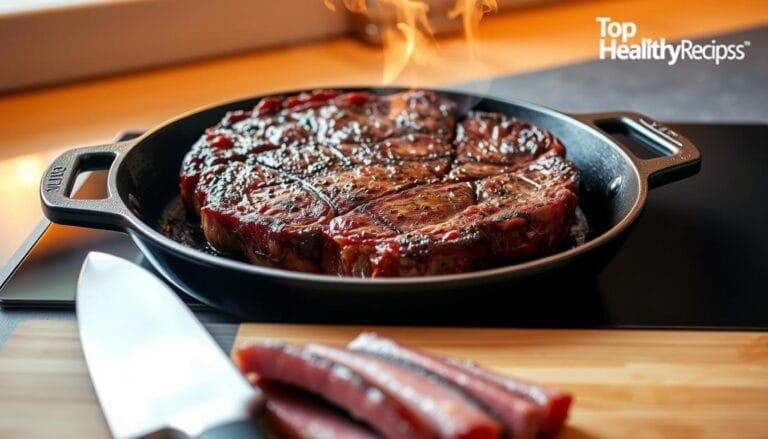What Is Delmonico Steak? Everything You Need to Know About This Cut
Table of Contents
What Is Delmonico Steak? Everything You Need to Know About This Cut
Have you ever wondered about the perfect steak? If you love steaks, you might have heard of the Delmonico steak. It’s been a favorite in fancy restaurants for a long time. Its rich history and special qualities make it loved by chefs and steak lovers.
So, what makes this cut so special? The Delmonico steak is tender and has a deep flavor. It’s a top choice for a fancy meal. Knowing about this cut can help you choose better steaks or order the right one at a restaurant.
Key Takeaways
- Understanding the characteristics of Delmonico steak
- Learning about its historical significance
- Identifying why it’s considered a premium cut
- Discovering its culinary versatility
- Appreciating its distinctive qualities
History of the Delmonico Steak
The story of the Delmonico steak is a blend of innovation and culinary greatness. It’s not just a piece of meat; it’s a symbol of fine dining with a long history. This history goes back to the 19th century.
Origins of the Name
The name “Delmonico” is linked to Delmonico’s Restaurant in New York City. Brothers Lorenzo and Giovanni Delmonico started this place. It was a leader in fine dining, offering menus that were ahead of its time.
The term “Delmonico steak” refers to a specific cut of beef. This cut was made famous by the restaurant. It’s often a ribeye or strip steak, known for its tenderness and taste.
Delmonico’s in New York City
Delmonico’s Restaurant was key in shaping American food. It opened in 1830, one of the first fine dining spots in the U.S. It introduced the à la carte menu, a big change at the time. This allowed people to order dishes individually, not just a fixed meal.
This new way of dining made the Delmonico steak famous. It became a key part of American fine dining. The restaurant also changed how people dined, making it more enjoyable.
Influential Figures in Delmonico’s Popularity
Many people helped make the Delmonico steak popular. Chefs, food critics, and Delmonico’s patrons all played a big role. Charles Ranhofer, a famous chef there, created dishes that highlighted the steak’s quality.
Authors and high society folks also helped. They made the Delmonico steak a sign of luxury and fine dining. Today, Delmonico’s legacy and its steak still shape American food.
Characteristics of Delmonico Steak
Understanding a Delmonico steak’s characteristics is key to its value. It’s known for its cut, texture, and flavor. This makes it a top choice among steak lovers.
Cut of Meat Explained
The Delmonico steak comes from the rib or short loin section of beef. This area is famous for its tenderness and rich flavor. The rib section, for example, has marbling that makes the steak juicy and flavorful.
The cut of a Delmonico steak is usually boneless. This makes it tender and easy to cook. It also makes the dining experience better by offering a uniform texture.
Texture and Flavor Profile
A Delmonico steak is tender and has fine marbling. Marbling adds flavor and tenderness. When cooked right, it tastes rich and indulgent.
“The secret to a great Delmonico steak lies in its marbling. The fat distribution within the meat is what gives it that tender, melt-in-your-mouth quality.”
The steak’s beefiness and umami flavors make it stand out. It has a unique flavor profile.
Cooking Methods Best Suited
Cooking a Delmonico steak right is key. Grilling and pan-searing are top choices. Grilling adds smoky flavor, while pan-searing gives a crispy crust.
- Grilling: Adds a smoky flavor and a charred exterior.
- Pan-searing: Creates a crispy crust on the outside while keeping the inside tender.
- Oven Roasting: Provides a consistent heat that cooks the steak evenly throughout.
| Cooking Method | Result | Best For |
|---|---|---|
| Grilling | Smoky flavor, charred exterior | Those who enjoy a charred, smoky taste |
| Pan-searing | Crispy crust, tender interior | Those who prefer a textural contrast |
| Oven Roasting | Evenly cooked, retains juices | Those who prefer a consistent doneness |
Types of Delmonico Steaks
The term ‘Delmonico steak’ can be confusing because it covers several cuts of beef. When you order or buy a Delmonico steak, you might find different types. This depends on the butcher, restaurant, or where you are.
The name “Delmonico” is linked to high-quality steaks at Delmonico’s Restaurant in New York City. Over time, it has come to mean several premium steak options, not just one.
Ribeye Variant
The ribeye variant of the Delmonico steak comes from the rib section. It’s known for its marbling, which makes the steak tender and flavorful. When cooked, it’s juicy and savory.
Key Characteristics of Ribeye Delmonico:
- Boneless cut from the rib section
- Exceptional marbling for tender texture
- Rich flavor profile
Strip Steak Variant
This variant is also known as a New York strip Delmonico. It’s cut from the short loin section. It’s firm and has a rich beef flavor. Unlike the ribeye, it has less marbling, making it slightly firmer but still tender.
Characteristics of Strip Steak Delmonico:
| Feature | Description |
|---|---|
| Cut | Short loin section |
| Texture | Firm |
| Marbling | Less than ribeye |
Sirloin Variant
Some places call a sirloin cut a Delmonico steak. It comes from the rear section, near the hip. It’s leaner than the ribeye and strip steak, offering a different taste and texture.
“The versatility of the Delmonico steak, in terms of the various cuts it can represent, is both a blessing and a curse. It allows for a range of flavors and textures, but can also lead to confusion if not properly understood.”
Knowing about the different Delmonico steaks can make your dining experience better. Whether you’re ordering at a restaurant or buying from a butcher, each variant has its own unique qualities. Exploring these options can help you find your favorite cut.
How to Choose a Quality Delmonico Steak
Choosing a top-notch Delmonico steak means knowing a few key things. These factors affect its quality and taste. When you’re at the butcher or store, knowing what to look for is crucial.
Marbling Indicators
Marbling is a big deal when it comes to a Delmonico steak’s quality. Marbling is the white fat in the meat. A higher marbling score means a tender and tasty steak. This fat melts when cooked, making the steak juicy and rich.
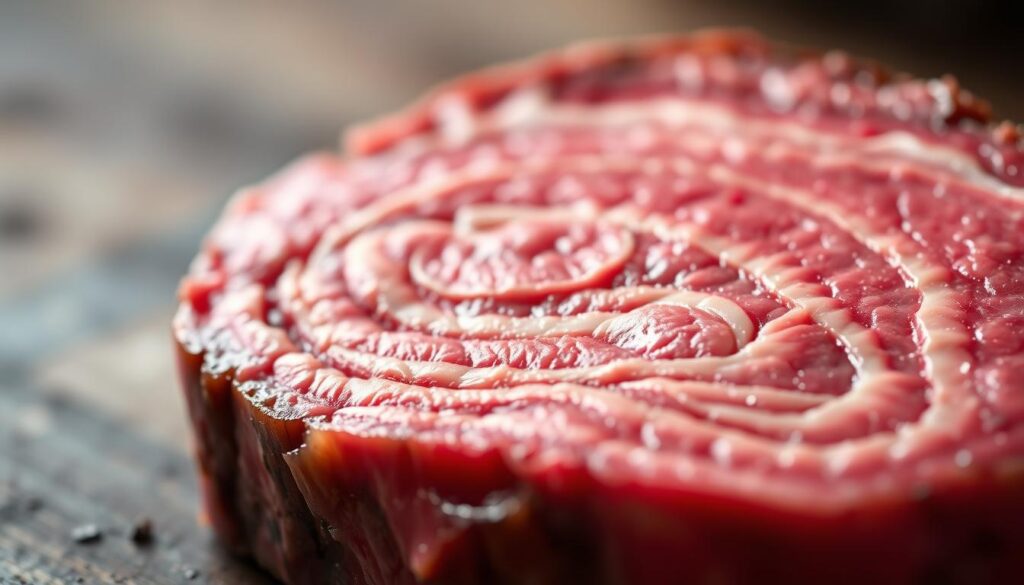
Color and Thickness Considerations
The color and thickness of the steak are also key. A fresh Delmonico steak should be a vibrant red. This shows it’s fresh and handled well. Steaks with brown or grayish colors might be old or handled poorly.
The steak’s thickness is important for even cooking. Thicker steaks cook better but might need longer cooking times.
- Optimal color: Vibrant red
- Thickness: 1.5 to 2 inches for grilling or pan-searing
Source of the Meat
The steak’s origin greatly affects its quality. Things like the cattle breed, how it’s fed, and aging methods matter. Grass-fed beef is leaner and tastes different from grain-finished beef, which is fattier and tenderer.
Look for labels or certifications that show the steak was dry-aged or wet-aged. These processes make the steak more tender and flavorful.
- Consider the breed and feeding practices.
- Check for aging processes like dry-aging or wet-aging.
- Look for relevant certifications or labels.
By looking at marbling, color, thickness, and origin, you can pick a great Delmonico steak. This ensures a fantastic dining experience.
Popular Cooking Methods
The Delmonico steak is known for its rich flavor and tender texture. It can be cooked in several ways to enhance its qualities. Grilling, pan-searing, and oven roasting are popular methods, each with its own benefits.
Grilling the Perfect Delmonico
Grilling adds a smoky flavor and a nice char to the Delmonico steak. Preheat your grill to 450°F to 500°F. Season the steak and grill for 4-5 minutes per side for medium-rare. Use a meat thermometer to check the internal temperature, aiming for 130°F to 135°F.
Grilling Tips: Oil the grates before grilling to prevent sticking. Consider using a grill mat for easier cleanup.
Pan-Searing Techniques
Pan-searing creates a crispy crust on the outside while keeping the inside juicy. Heat a skillet or cast-iron pan over high heat. Add oil and sear the steak for 3-4 minutes per side. Finish with butter-basting for extra flavor.
Pan-Searing Tips: Use a hot pan and don’t overcrowd it. Cook undisturbed for a few minutes on each side to get a good crust.
Oven Roasting Tips
Oven roasting is great for thicker steaks or when grilling isn’t possible. Preheat your oven to 300°F. Season the steak and sear it in a hot pan before roasting. Roast until the internal temperature reaches your desired doneness.
Oven Roasting Tips: Use a meat thermometer to check for doneness. Let the steak rest for a few minutes before serving to allow the juices to redistribute.
| Cooking Method | Temperature | Cooking Time |
|---|---|---|
| Grilling | 450°F – 500°F | 4-5 minutes per side |
| Pan-Searing | High Heat | 3-4 minutes per side |
| Oven Roasting | 300°F | Until internal temperature is reached |
Ideal Seasoning and Marinades
Seasoning a Delmonico steak is all about finding the right balance. You want to enhance its natural taste without overwhelming it. This makes the steak a standout dish.
Salt and Pepper: A Purist’s Approach
Many steak lovers prefer a simple seasoning of kosher salt and black pepper. This lets the steak’s natural flavors take center stage. It’s key to know when to season and how salt affects the meat.
Seasoning too early can dry out the steak. Seasoning too late might not let the flavors sink in. Season about 45 minutes to an hour before cooking. This helps create a tender crust.
Herb-Based Marinades
Herb marinades can add depth to your Delmonico steak. Rosemary, thyme, and garlic complement the steak’s rich taste. They also add aromatic notes that make the meal more enjoyable.
Make a simple marinade with garlic, herbs, olive oil, and lemon juice. The lemon’s acidity tenderizes the steak. The herbs add their unique flavors.
Unique Flavor Combinations
There are many ways to spice up your Delmonico steak. Compound butters, like truffle or blue cheese, add a creamy touch. They’re made by mixing flavors into softened butter and melting it over the steak.
Coffee rubs and whiskey glazes are also great. Coffee’s bitterness pairs well with the steak’s richness. A whiskey glaze adds a sweet, caramelized crust. When trying new flavors, aim to enhance the steak without overpowering it.
Serving Suggestions
A Delmonico steak is more than a meal; it’s an experience. Pairing it with the right sides can make it unforgettable. Choose sides that enhance its rich flavor.
Sides that Pair Well
Classic choices like creamed spinach and twice-baked potatoes are favorites for a reason. They match the steak’s bold taste without taking over. For something new, try roasted Brussels sprouts with bacon or truffle mashed potatoes.
- Creamed Spinach
- Twice-Baked Potatoes
- Roasted Brussels Sprouts with Bacon
- Truffle-Infused Mashed Potatoes
Best Wine Pairings
The right wine can make your Delmonico steak even better. Red wines like Cabernet Sauvignon and Malbec are great because they match the steak’s bold taste. If you prefer white, Chardonnay offers a nice contrast.
| Wine Type | Characteristics | Pairing Reason |
|---|---|---|
| Cabernet Sauvignon | Full-bodied, tannic | Complements bold flavors |
| Malbec | Fruity, smooth | Enhances steak’s richness |
| Chardonnay | Buttery, oaky | Contrasts with steak’s savory flavor |
Presentation Tips
How you present your meal can make it feel like a fancy restaurant at home. Use decorative plates and fresh herbs to highlight the steak. Also, choose sauce presentations that add to the dish’s appeal.
By focusing on these details, you can make a simple meal into a memorable experience. It will impress your guests and satisfy your taste buds.
Common Mistakes to Avoid
To enjoy a Delmonico steak, you must avoid common mistakes. This steak is cut from the rib or strip section. It’s known for its rich flavor and tender texture.
One big mistake is overcooking the steak. Overcooking makes it tough and dry. To avoid this, check the internal temperature. For medium-rare, it should be 130°F to 135°F. A meat thermometer helps get it just right.
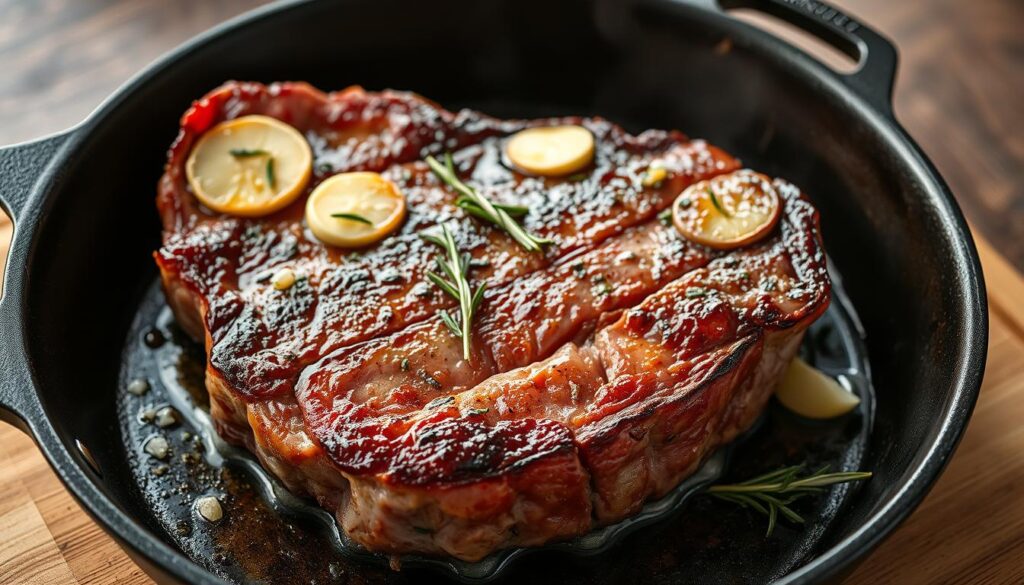
Incorrect Seasoning Techniques
Another mistake is using the wrong seasonings. Too much seasoning hides the steak’s natural taste. Use fresh, quality seasonings and season just before cooking.
Salting at the right time is also key. Salting too early can dry out the steak. Salt it just before or during cooking.
The Importance of Resting Time
Not letting the steak rest is a big mistake. Resting redistributes juices, making the steak tender and flavorful. Resting time depends on the steak’s thickness, but a few minutes is usually enough.
Other mistakes include improper thawing, cooking from the fridge, and using the wrong tools. Being aware of these can help you cook a perfect Delmonico steak.
To sum up, cooking a Delmonico steak right means controlling temperature, seasoning correctly, and letting it rest. Follow these tips for a delicious, tender steak.
Health Benefits of Delmonico Steak
Learning about the health benefits of Delmonico steak can guide your diet choices. This beef is famous for its taste and softness. It also has many nutritional perks.
Nutritional Profile
Delmonico steak is packed with nutrients but has a lot of calories because of its fat. It has protein, fats, and vitamins and minerals. The exact nutrients depend on the steak’s thickness, marbling, and cooking method.
Protein Content
Delmonico steak is high in quality protein. Protein is vital for muscles, immune health, and overall well-being. Beef, including Delmonico steak, has all the amino acids your body needs. Eating Delmonico steak helps support these functions.
Iron and Other Minerals
Delmonico steak is also rich in iron, which helps prevent anemia by making hemoglobin. It’s also a good source of zinc, phosphorus, and B vitamins. These nutrients are key for energy and immune health. Adding Delmonico steak to your diet can help meet your nutritional needs.
When you eat Delmonico steak, think about portion sizes and how often you eat it. Eating it in moderation lets you enjoy its benefits without the risks of too much red meat.
Delmonico Steak in Popular Culture
The Delmonico steak is more than just a dish; it’s a cultural icon. It’s seen in movies, TV shows, and on social media. This steak symbolizes fine dining and class.
In films and TV, the Delmonico steak shows luxury and high society. Characters enjoy it in fancy restaurants, showing its exclusivity. Cooking shows often feature it, highlighting the skill needed to cook it right.
References in Film and Television
Films and TV shows often use the Delmonico steak to show off fine dining. Celebrity chefs and food critics talk about it a lot. This makes it even more popular in culture.
A famous food critic once said:
“The Delmonico steak is more than just a cut of meat; it’s an experience that embodies the essence of fine dining.”
This view is shared by many in the culinary world.
Celebrity Chefs and Recipes
Celebrity chefs have made the Delmonico steak famous. They’ve come up with unique recipes and cooking methods. You can find many recipes online to make the perfect Delmonico steak.
Some chefs share stories about cooking Delmonico steaks. They talk about cooking it for special events or trying new seasonings. These stories make the steak seem more approachable for home cooks.
Social Media Trends
Social media has boosted the Delmonico steak’s popularity. On Instagram, you’ll see beautifully presented Delmonico steaks. Chefs and home cooks share their dishes. The hashtag #DelmonicoSteak is popular for sharing experiences and photos.
On TikTok, short videos of cooking Delmonico steak have become hits. People share quick recipes for this luxurious cut. Social media has made the Delmonico steak appealing to a younger audience.
Exploring the Delmonico steak reveals its deep cultural significance. It’s a mix of tradition, luxury, and modern cooking.
Resources for Further Reading
Now that you know about the Delmonico steak, its history, and how to cook it, you can learn more. Exploring various sources can deepen your understanding of what a Delmonico steak is and what cut of beef it comes from.
Authoritative Books
Books like “The Steak Bible” and “The Joy of Cooking” are great for learning about steak. They have detailed guides on premium cuts, including the Delmonico. These books share cooking techniques and the history of American steakhouse traditions.
Recommended Online Resources
Online, you can find websites and blogs from famous chefs and butcher shops. They offer in-depth information on Delmonico steaks. You can also check out online cooking classes and video tutorials from top culinary schools.
Online Classes and Tutorials
Want to get better at cooking a Delmonico steak? Online cooking classes are a great option. These classes, taught by culinary experts, will walk you through the process. From choosing the right cut to cooking it perfectly, you’ll learn it all.
FAQ
What is a Delmonico steak?
What cut of beef is a Delmonico steak?
How do I choose a quality Delmonico steak?
What are the best cooking methods for a Delmonico steak?
How should I season my Delmonico steak?
What are common mistakes to avoid when cooking a Delmonico steak?
What are the health benefits of Delmonico steak?
How is Delmonico steak represented in popular culture?
For more cooking tips, stay connected with us. We also recommend the cookbook Skinnytaste Simple: Easy, Healthy Recipes with 7 Ingredients or Fewer
For more Recipes about Steak ?
Did You try our recipe ?
There are no reviews yet. Be the first one to write one.
